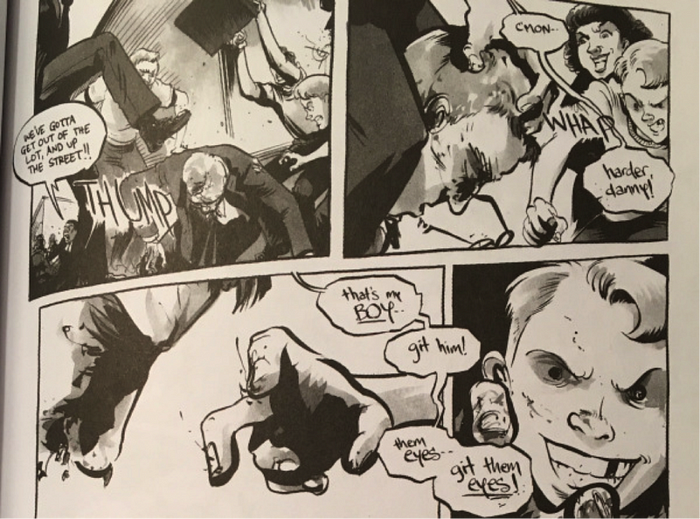You're reading for free via Matthew Teutsch's Friend Link. Become a member to access the best of Medium.
Member-only story
“Our laws must be upheld”
When I was younger, I used to watch old black and white television shows on Nick at Nite and other channels. After watching the shows, I used to think that people, before the advent of color television or even technicolor, saw only in black and white. I used to think that what they saw through their eyes consisted of only two colors and shades in between. Thinking back on this, the idea that people only saw in black and white created within my mind a distance, a distance that created the period of these television shows or movies as bygone eras, eras far removed from my birth in 1978.
Whenever we see images from the Civil Rights era, only about 50 years ago, we continually see them depicted in black and white, giving them a distance from our current moment. Martin Luther King, Jr. was assassinated in 1968. I saw the iconic photograph of Andrew Young, Jesse Jackson, and Juanita Abernathy pointing in the direction of the gunshot as Rev. Ralph Abernathy knelt beside King in black and white, rarely, if ever, in color. King’s assassination occurred ten years before my entrance into the world. At that time, networks had been airing color television shows since about 1954. Yet, the majority of the images we see from the era are not in color, they are in black in white.
The black and white nature of the photographs, while powerful, create within us a temporal distance, situating the events in a far distant past, far removed from the present. When we break down the generational links to the past and use seventy as the average life span of an individual, we are barely one generation removed from the Civil Rights era. We are two to three removed from Jim Crow and segregation. We are four to five removed from Reconstruction and enslavement. This means that individuals who lived through or came of age during the Civil Rights era are still alive. James Meredith, the man who integrated Ole Miss, is 87. Ruby Bridges, who as a girl integrated New Orleans public schools, is 65. John Lewis was 80 when he passed.
After she read John Lewis, Andrew Aydin, and Nate Powell’s March, my wife thought about the moment when the Freedom Riders entered Montgomery, AL, on May 19, 1961, and were met with mob violence as the police stood by and watched. She thought about the fact that many of the people who took part in the mob violence may still be alive. If they aren’t still alive, then their children and grandchildren are alive. She thought about the scene with the young boy who goes for a Freedom Rider’s eyes as his father cheers him on. That boy, if alive, would be in his 60s today, still alive with children and grandchildren.

After a 17-year-old shot and killed 26-year-old Anthony Huber and 36-year-old Joseph Rosenbaum during protests over the officer involved shooting of Jacob Blake in Kenosha, WI, Vice President Mike Pence, during his acceptance speech at the Republican National Convention on August 26, told the audience, “The violence must stop, whether in Minneapolis, Portland or Kenosha, too many heroes have died defending our freedom to see Americans strike each other down. We will have law and order on the streets of this country for every American of every race and creed and color.”
August 28 marked the 57th anniversary of the March on Washington for Jobs and Freedom. That was the march, in 1963, where King delivered his famous “I Have A Dream” speech. About a week before the 1963 march, The Shreveport Times printed an editorial entitled “Our Laws Must Be Upheld.” The editorial begins with this:
The one bright spot on the horizon of the “Negro rights” revolution sweeping the country is the steadily increasing public revulsion against the avalanche of propaganda that it is all right for Negroes and their white supporters to break laws in bloody street demonstrations because the so-called “rights” they seek are something that are “supposed” to have.
There is a lot to parse here, but the key is that the rhetoric sounds eerily familiar. It sounds like Pence’s comments at the RNC. As well, the rights that King and others argued for at the march were for human rights, rights that America had reneged on from its inception. King told the crowd gathered at the National Mall, “We can never be satisfied as long as the Negro is the victim of the unspeakable horrors of police brutality.”
The commentator continued by stating, “That is simply jungle law-if you don’t like something, destroy it.” Again, this sounds familiar. First and foremost, the connotation of “jungle law” calls to mind false ideas of “civilization” and positions those fighting for equity as inferior to those supposedly striving to uphold law and order. This is key because it painted the marchers as savage, uncivilized, and as inferior, as if they ignored the law because it did not fit them. In fact, they challenged unjust laws and were met with violent resistance. Remember the murders of Jimmie Lee Jackson, James Reeb, Viola Liuzzo, Medgar Evers, Malcom X, Martin Luther King, Jr. . . .
Continuing, the writer argues that the marchers are fanatics, as if propelled by God, to upend the unequal laws on the books. They say, as the commentator imagines,
It’s all right for me to break a law if I say that the so-called Negro rights are the objective, but it’s not right for you to uphold laws which for decades have protected the established rights of all people of all colors if I object.
Here, the writer presents the marchers and “protesters” as simply pushing back against any laws they don’t agree with. That is not the case, though, as we know, The laws (redlining, Jim Crow, vagrancy, etc. . .) did not protect “all people of all colors.” If they did, then would the Civil Rights movement even be necessary?
The key here, of course, is that 57 years ago, as activists prepared to march on Washington, people presented the march as a threat to democracy, as a threat to law and order because in American laws protected everyone. Everyone had the opportunity to succeed. Everyone was equal. So, the protests were merely violence for violence sake. They were marches to get out of work. They were, in effect, “jungle law.”
After the march, Shreveport’s Public Safety Commissioner George D’Artois wrote an article for the Shreveport Times calling the march a “flop.” D’Artois, who would later be involved in the murder of his former campaign manager in 1974, went to Washington along with Shreveport Police Chief Harvey D. Teasley. They went to “observe the demonstration” and to meet with a local representative.
King had come to Shreveport in August 1958 to speak at Galilee Baptist Church and to fight against voter suppression in the area and in Louisiana. Around 500 people gathered at the church to hear King speak, and as he spoke, “They paid a price for it,” as Dr. C.O. Simpkins stated, “because their cars were vandalized. One of the windshields was broken. They got tickets. And I got a phone call they were gonna kill me. Kill King. And do things to my children. All kind of negative things that they said, to try and discourage people from coming.” But, people came.
[vimeo 129077545 w=640 h=360]
Shape of Shreveport — Episode 3 — Two Kings from Strategery on Vimeo.
This was the atmosphere in Shreveport five years before the March on Washington for Jobs and Freedom. This was the atmosphere in Shreveport that drove two city employees to go to Washington to “observe” the march. This was the atmosphere in Shreveport that led to the newspaper calling the march and protests “jungle law.”
Continuing his communique about the march, D’Artois relayed that the white demonstrators looked like “beatniks” and that most of those who showed up “were from within a 300-mile radius of Washington,” and “that only two local integration groups were planning to participate.” He went on to attack the attire of Blacks who attended the march, saying they were “shabbily dressed” and “clad in overalls.” Any picture from the demonstration shows that this is a drastic mischaracterization, used to paint Black and white demonstrators as slovenly. D’Artois even argues that only 80,000 people attended, well below the 250,000 who actually attended.
We must remember that the Civil Rights era did not end in the 1960s. We must remember that the Civil Rights era occurred one and two generations from the present. We must remember that racism did not end in the late 1960s. We must remember that systems that oppress Black and Brown individuals and keep poor whites down did not end in the late 1960s. We must remember that law and order evolved, shifted, maneuvered to maintain positions of power. We must remember that calls for equity and equality are calls for change. They are calls that people cry out to be seen as human.






